 资源简介
资源简介
(共22张PPT)
新人教版高中英语必修三Unit2 Morals and Virtues
Reading for Writing
The Race Between Tortoise And Hare
Modesty helps one go forward,
whereas conceit(自负) makes one lag behind
Lead in
Lead-in:Discussion
The characteristics of fable
fable 寓言
It’s a kind of traditional short / long story.
It teaches a moral / practical lesson.
It’s usually a story with animals / real persons / virtual persons as characters.
Lead-in: The Morals of fable stories
Practice makes perfect.
More haste, less speed.
It’s never too late to learn.
Well begun is half done.
Lead-in: The Morals of fable stories
When in Rome, do as the Romans do.
Seeing is believing.
No pains, no gains.
A friend in need is a friend indeed.
Pre-reading: The Moral of fable
The Stone in the Road
What will you do if you come across a big stone in the middle of the road
walk across it
ignore it
trip over --- get angry
move it away
...
Analyse the structure of the text.
Part 2
para. ____
Different people’s _________ and _________ when they came across the same problem.
What _______ the king taught his people.
Part 1
para. ____
Part 3
para. ____
Why the king wanted to __________________ and what _______ was.
THE STONE IN THE ROAD
teach his people a lesson
his idea
emotions
responses
lesson
1-2
3-7
8-9
Reading
1. Read the fable below and answer the questions.
1. What was the king’s idea for teaching an important lesson to his people
He put a huge stone in the middle of a road, and watched to see if anyone would move it.
2. What was the response from most of the people
Most of the people just got upset that the stone was in their way.
3. What did the young girl think and do when she saw the coins
She thought that the money belonged to someone else and that it should be returned.
Reading
Step 2. Complete the table according to the story.
Person Experience Emotion Response
milkman
woman with water
other villagers
young girl
crashed into the stone
angry
went away
tripped over the stone
sad
limped away
in tears
complained
about the stone
upset
nobody made an attempt to move the stone
succeeded in moving the stone to the side of the street
tired,
surprised
wanted to find the owner of the gold
The lesson is taught to first-year high school students, who are able to actively participate in the class. After learning the content of the first three lessons, students have enriched the vocabulary and expressions of the unit theme, and have the ability to read fables and summarize the meanings.
已有基础
Students are unfamiliar with the structural elements of a review. Usually students focus on the plot and moral of the fable after reading it, and the teacher should use this as a starting point to inspire students to think deeply about the meaning of the theme of "morals and virtues".
突破空间
Cultivate students' ability to analyze and evaluate the behavior of characters dialectically, encourage students to develop multi-angle imagination of open-ended endings, enable students to reasonably infer the author's intentions, and finally, express personal opinions in an orderly manner.
发展需求
2. Analysis of students
Identify the structure and main points of a story review, and write a review of a fable to develop critical thinking and then practice virtues.3Express opinions on the meaning and purpose of the fable by analyzing the storyline and the behavior of the characters.2Describe the characteristics, the implicit truth or educational significance of fables.13. Teaching and learning objectivesText hereFocal pointsText hereDifficult points1.to guide students to dialectically evaluate character behaviors from multiple perspectives;2.to help students to write a short review that is clear and logical.6. Teaching procedures
Leading in
Get to know what a fable is.
Activity 1
First reading
1.Get the general information about the story;
2.Appreciate the language structure.
Activity 2
Second reading
1.Understand the deep connotation of this moral story through the comparison of characters' words and deeds;
2.Conclude the author’s purpose;
3.Express opinions on this story.
Activity 3
Preparing for the writing
1.Study the organization of a story review;
2.Find the useful expressions.
Write a story review with a clear point of view and proper organization and language.
Activity 4
Writing a review of the fable
Summary
&
Assignment
Polish your review.
Leading in 3’
设计意图
应用学生们耳熟能详的寓言故事,通过看图猜故事的读前引入活动,让学生了解寓言故事这一文学体裁及其特殊的教育意义。
学习效果评价
学生通过观察以及对已有经验的调取,明确表述出寓言故事的名字、情节以及教育意义。
6. Teaching procedures
First reading 20’
设计意图
熟悉文本,通过阅读提取细节信息,并通过文中的直接描述与对人物的语言、行为的描写,判断人物情绪、态度。该活动结合了读写技能训练,锻炼学生的综合语言运用能力,为后续写作做好铺垫。
学习效果评价
学生通过阅读,能够复述故事情节,以及根据人物的语言、动作、做出的选择推断总结出人物的情感表现与性格特征。
学生能够通过分析、改写明确现在分词做状语与宾语补足语的作用与应用。
6. Teaching procedures
Second reading 17’
设计意图
引导学生深入讨论和分析这则寓言故事和实际生活的联系以及其深层寓意。鼓励学生基于故事充分发表自己的看法和见解,有利于培养学生的批判性思维和创造性思维,并树立正确的价值观和人生观。为下面的写作活动做好内容准备。
学习效果评价
学生能够结合现实实际从不同方面阐释出寓言故事中不同物体与人物所代表的意义。
整句表述,并用上本单元的主题词块和语言结构。
表述内容积极向上,并且体现批判性思维和创造性思维。
6. Teaching procedures
Preparing for writing 15’
设计意图
学习效果评价
学生能够梳理并总结出读后感这一体裁的基本框架、特点以及常用语言表达,并能应用到之后的写作实践中。
6. Teaching procedures
教师提供一篇读后感作为案例分析材料,学生结合教材提供的提纲来分析读后感每一个段落应该包含的要点,让学生掌握读后感这一体裁的基本框架和特点。
同学们从范文中吸收有用语言表达,在写作时参考使用,实现语言的迁移应用。
Writing a review of a fable 30’
设计意图
1. 学生了解读后感的评价标准,能在动笔之前明确需要兼顾的要求和应注意的问题。
2.学生交换草稿并给予反馈,让学生学会评价同伴的写作成果。
学习效果评价
能够用合适的篇章结构和语言特点呈现一篇字数达标、要点齐全、表达逻辑、分析合理、观点积极的读后感。
能够运用给出的评价标准合理的评价其他同学的作品以及修改自己的读后感。
6. Teaching procedures
Requirements:
(1)The number of the words should be about 100.
(2)Use at least one -ing form as the adverbial or the object complement.
(3)Use at least two words or expressions that involve the qualities of the figures, the moral dilemma, the life choices and so on.
(4)Think critically and show the correct values for moral and human issues.
3.Exchange drafts. Use the checklist to give feedback on your partner’s draft.
◆Does the writer give his/her opinion about the characters or their actions or the story critically
◆Does the review reflect the correct and positive values
◆Does the writer use the -ing form as the adverbial or the object complement in the review
◆Does the writer use the words and expressions related to this topic
◆Are there any grammar, spelling, or punctuation errors
Summary & Assignment 5’
设计意图
对整节课的学习内容进行总结、反思与整理、巩固。
学习效果评价
能够通过评价反馈,修改、润色自己的读后感。
6. Teaching procedures
Revise the draft and put up the review in the classroom. 给予学生展示自我的机会,增强学习的信心和兴趣,并促进学生互相学习。
7. Blackboard design
The milkman:
The women:
The girl:
Para1:
Basic information about the story
Para2:
Your analysis of the story
Para3:
Your opinion about the story
B3U2 Morals and Virtues (Reading for Writing)
---Write a review of a fable
The stone
The gold coin
The road:life/community/society
The king’s purpose:
The author’s purpose:
8. Teaching reflection
Based on the requirements of the course standards, this lesson embodies the principle of consistency of "teaching evaluation", and the design of learning activities follows the guidance of the concept of English learning activities.
01
03
02
评价
Assessments
活动
Activities
目标
Outcomes
以终为始
教、学、评一体化
反思不足
不足之处1
There is not enough time in class for students to have more opportunities to show their works, and it’s better to use the after-class time to make face-to-face corrections on students' assignments, give specific revision suggestions, and improve students' language skills.
不足之处2
It’s better to supplement more Chinese and foreign fables in class, and some English fables can be recommended to students after class as an extension of the knowledge learned in class.
设计思路特色
Thank you for
watching.
Speaker name and title
OfficePLUS
hank
展开更多......
收起↑
 资源预览
资源预览
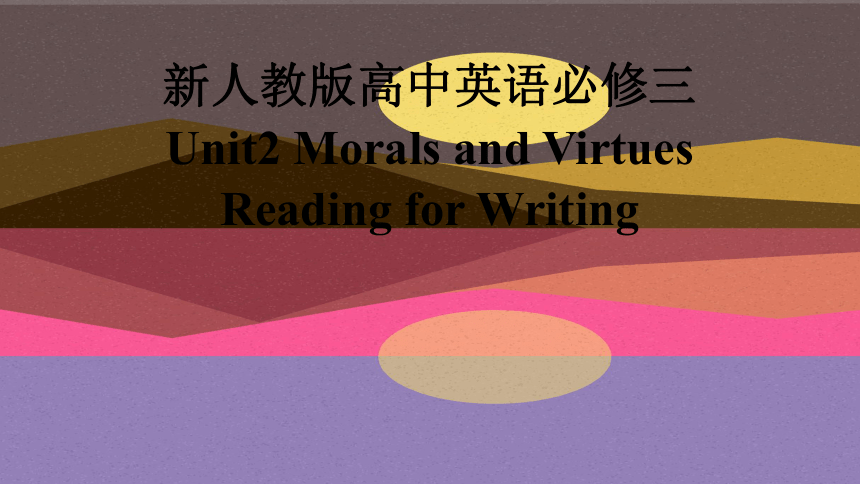

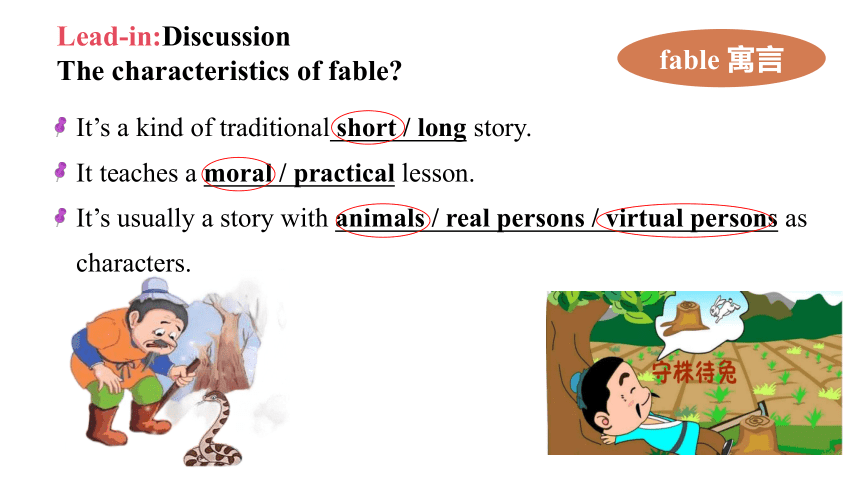


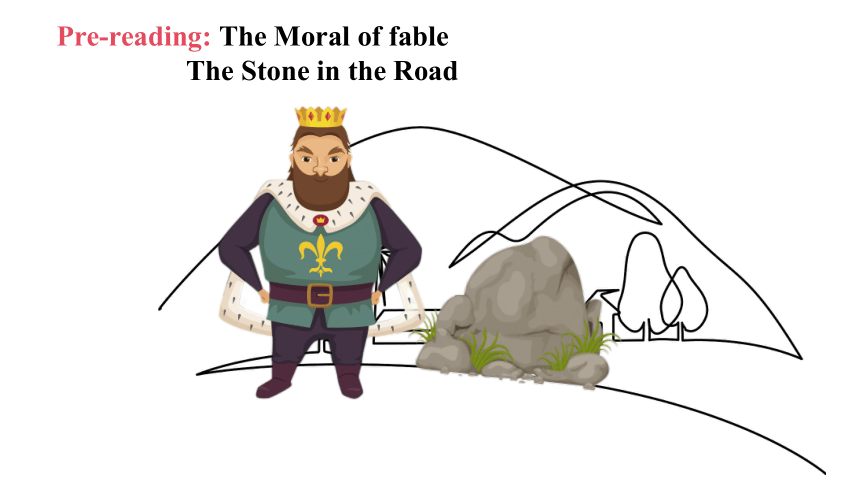
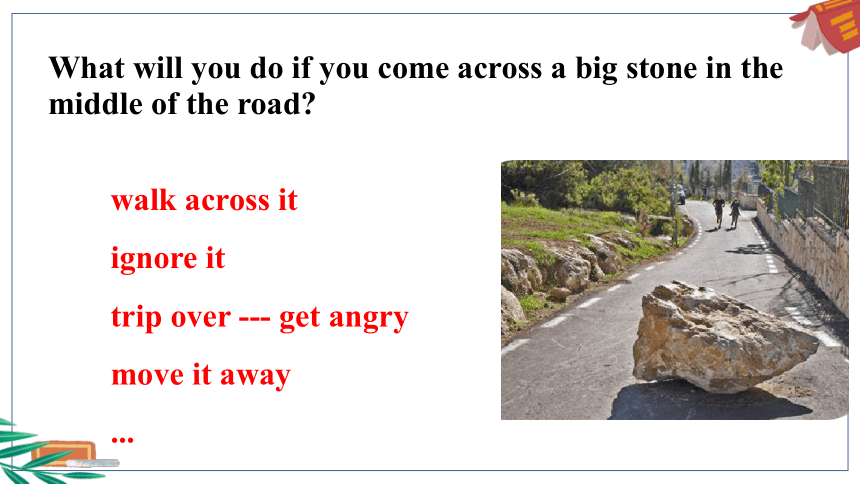
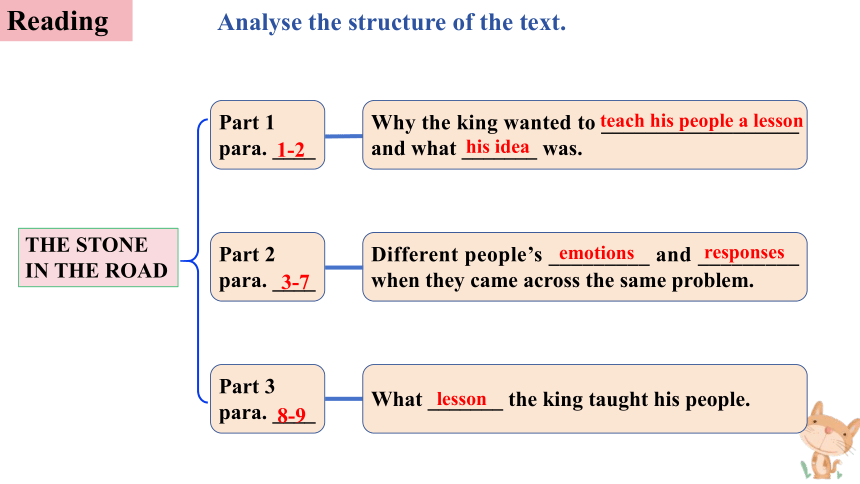

 资源预览
资源预览








